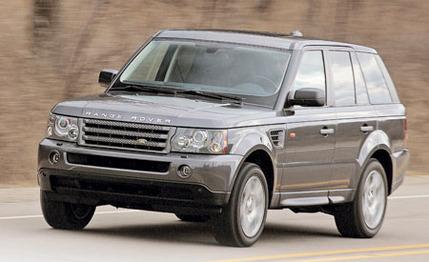 Short Take Road Test
Short Take Road Test
Before you read any further, check out the specs here. Anything jump out at you? The surprise is not the horsepower, the 0-to-60-mph time, the skidpad number, or the price.
The shocking thing about the Range Rover Sport is how amazingly well it stops. Our 5629-pound HSE test vehicle did the 70-to-0-mph deed in just 165 feet, which far outclasses everything in its SUV category, including the Cadillac Escalade and Lincoln Navigator, and by a distance of more than 20 feet. The stop was only four feet longer than the number produced by the last Corvette we tested. The only comparable SUVs that come close - besides its platform-mate, the LR3 - are smaller, unibody utes like the BMW X5 or Mercedes M-class, which weigh at least 500 fewer pounds.
We understand that most enthusiasts don't buy a car because it stops well, but think of that 20-foot advantage as about one-and-a-half car lengths. In a panic situation, it could make a substantial difference. This feat is abetted by a rear-biased weight distribution (51.3 percent) as well as high-performance Goodyear Wrangler F1 tires. We tried unsuccessfully to get an official explanation from Land Rover engineers.
The Range Rover Sport is a new-for-2006 model that is positioned between the LR3 and Range Rover. It's essentially a slightly shorter LR3 with a four-inch haircut and reshaped to look more like the fashionable Range Rover. That look, however, nixes the third-row seat and causes things to get a little cramped inside. Compared with the LR3, the Sport loses an inch of headroom and 3.3 inches of legroom up front, and four inches of headroom in back. But the interior, although based on LR3 goods, is finished with upscale pieces, such as silver-colored accents on the door pulls, vents, and center stack, and expensive-looking low-gloss wood trim throughout.
The base HSE model, tested here, comes with the 300-hp, 4.4-liter naturally aspirated DOHC V-8 also found in the LR3 and Range Rover. Its price falls squarely between family members: A Sport HSE starts at $57,250, which, compared with identically powered Rovers, is $11,550 more than the LR3 and $18,500 less than the Range Rover. It's also 13 grand cheaper than the 390-hp supercharged Range Rover Sport.
Any SUV with the word "sport" in its name is asking for persiflage on these enthusiast-written pages, but this Rover does hint at the s-word with remarkably supportive seats (part of the $3000 Luxury Interior package on our car) and positive steering feedback through a fat leather wheel. The exhaust note is much gutsier than the LR3's and urges the driver to keep his foot in it (maybe that's why we averaged 12 mpg).
However, the Sport has noticeable pitch and roll, and it doesn't ride any lighter on its tires than other big utes. And despite what the jumpy throttle suggests, in a straight line the Rover is exactly as sporty as a $15,720 Honda Fit Sport manual, accelerating to 60 mph in a leisurely 8.7 seconds and dawdling past the quarter-mile stripe in 16.7 seconds. Skidpad grip is also yawn-worthy at 0.74 g.
But if you've been mortified in a horsepower-flexing encounter with a 403-hp Escalade, be comforted knowing how safe you and yours are in this short-stopping Range Rover Sport.